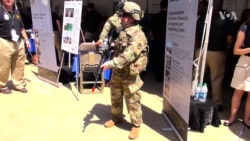Robot teammates and "snake" arms that can find a crack .005 millimeter long were just two of the U.S. military's latest technological innovations on display at the Pentagon this week.
The Defense Laboratory Enterprise showcased more than 80 exhibits on its biennial Lab Day on Thursday. The enterprise is a network of 63 defense laboratories, warfare centers and engineering centers that operate across the United States, and the event provided the Defense Department community with an up-close look at projects in various stages of development and readiness.
Here are some of VOA's favorites:
Soldier Visual Integrated Technology
Imagine a soldier comes across a suspicious object that she has never seen before. As she stops to explore, she immediately sees an enemy fighter and has to spring into action without time to fully raise her weapon's sight up to her eye. And she's unable to see another enemy lurking around the corner.
With Soldier Visual Integrated Technology, the soldier can better see her surroundings and needs less time to react to dangers accurately.
Ronald Geer, a staff sergeant assigned to the Army's Communications-Electronics Research, Development and Engineering Center, says SVIT wirelessly links three pieces of technology on the soldier: a reticle eyepiece, a thermal device on the gun and a communications system attached to the chest.
"What this is going to do is increase my speed and lethality on the battlefield, especially in a close combat situation," Geer said. "I don't have to worry so much about raising my weapon to an exact point where I'm able to view through this [his thermal device], because as I raise the weapon, what this is looking at, I'm able to immediately see pulled into the reticle device."
The connectivity also allows soldiers to use their guns to see what's around a corner without having to move their bodies into harm's way.
SVIT updates in real time as well, providing a way to virtually "mark" obstacles or enemy weaponry so that other soldiers can see what the SVIT user views.
Remote Access Nondestructive Evaluation
Jokingly called a "snake on a plane" by some at the Air Force Research Laboratory, R.A.N.D.E. (pronounced Randy) is a robotic arm that can wriggle through an opening as small as 7 centimeters to inspect the interior of aircraft wings or other structures without dismantling them.
Senior Materials Engineer Charles Buynak told VOA that any sensing device can be attached to R.A.N.D.E. to look for minute structural defects.
"We're looking for things on the order of 1/50,000th of an inch [.00508mm] — before a crack becomes a major thing ... and becomes a serious problem to the aircraft," Buynak said.
The system is driven by a controller from an Xbox 360 home video game console. Buynak said that makes R.A.N.D.E. easy for young operators to use. Another reason is that the Air Force wanted to take advantage of technologies already available.
"Why go spend money developing something that's easily available that we can adapt to our application here?" he said.
Robots as teammates
The U.S. Army is developing ways to use robots not as tools but as teammates. The Army Research Laboratory displayed several robots this week that can be used as hosts for developing software algorithms for artificial intelligence and machine learning purposes.
Stuart Young, chief of the Asset Control and Behavior Branch, told VOA the goal is to protect soldiers by using technology to "manipulate unknown objects in an unknown world."
His team is trying to develop AI algorithms that can generalize and understand what's going on in a robot's environment. "And then once we have that information," Young said, "we can manipulate it to accomplish the mission that the robot needs to accomplish."
Such robot missions could range from breaching an enemy's defensive position to removing improvised explosive devices, or just moving large objects out of the way while soldiers are in a safer location.









